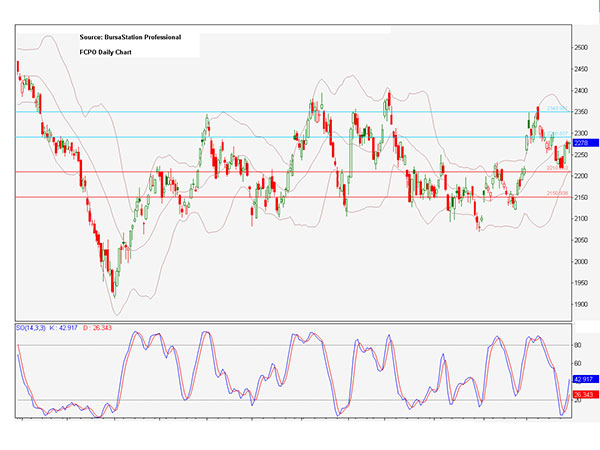 Malaysian palm oil futures climbed higher on Friday to 2,278, while heading for their first weekly gain in three weeks, as the ringgit continued to retreat. However, caution over Indonesia’s new palm export levies weighed on the price.
Malaysian palm oil futures climbed higher on Friday to 2,278, while heading for their first weekly gain in three weeks, as the ringgit continued to retreat. However, caution over Indonesia’s new palm export levies weighed on the price.
Future Crude Palm Oil (FCPO) benchmark September 2015 contract settled at 2,278 on Friday, up 38 points or 1.7 per cent from 2,240 last Friday.
Trading volume decreased to 134,269 contracts from 169,344 contracts from last Monday to Thursday.
Open interest based increased to 761,695 contracts from 735,865 contracts from last Monday to Thursday.
Cargo surveyor, Intertek Testing Services (ITS), reported that exports of Malaysia’s palm oil products during June 1 to 20 increased 0.4 per cent to 1.074 million tonnes compared with 1.07 million tonnes during May 1 to 20.
Intertek Testing Services (ITS) reported that exports of Malaysia’s palm oil products during June 1 to 25 increased 1.3 per cent to 1.4 million tonnes compared with 1.383 million tonnes during May 1 to 25.
Another cargo surveyor, Societe Generale de Surveillance (SGS), reported that Malaysia’s palm oil exports during June 1 to 20 increased 3.3 per cent to 1.082 million tonnes compared with 1.047 million tonnes during May 1 to 20.
SGS’ report showed that Malaysia’s palm oil exports during June 1 to 25 decreased 0.8 per cent to 1.393 million tonnes compared with 1.405 million tonnes during May 1 to 25.
Overall, demand rose from the US and EU, while demand weakened from China and India.
Spot ringgit weakened on Friday to 3.766, due to concerns that Fitch ratings agency was preparing to downgrade Malaysia’s credit rating, partly as a result of debts run up by state fund 1MDB.
Market players are watching for possible changes to regulations in the world’s top palm producer, Indonesia, after the head of the public body that will manage the funds from a new levy said it might review some of the charges.
Plantations Industries and Commodities Minister Datuk Amar Douglas Uggah Embas said on Wednesday that Malaysia is on track to raise its biodiesel mandate to B10 in October from the current B7 while the the proposal to increase the blend to 10 per cent palm biodiesel initially was opposed by several carmakers including BMW Malaysia.
The Malaysian Palm Oil Association (MPOA), a group of growers, estimated that production dipped 1.8 per cent during June 1 to 20 from a month earlier, as yields in top-growing state Sabah fell.
On Monday, the price fell, while staying range-bound and with lower volume than normal, touching the lowest in three weeks, as the ringgit gained and lacklustre exports in the first 20 days of the month signalled diminishing demand for the edible oil.
On Tuesday, the price saw little change, while volume remained thin. As the price erased some gains following a dip in overseas soy markets, paired with a lack of clarity over export demand in the coming month, prices were kept in a tight range.
On Wednesday, the price rose to the highest level in a week, whilst volume remained above average, climbing for the secondd consecutive day, due to the ringgit weakening, which makes the ringgit-denominated palm feedstock cheaper for overseas customers.
On Thursday, the price fell, retreating from a one-week high, as investors turned cautious over diminishing export demand, though a weak ringgit currency kept a lid on losses.
On Friday, the price rose in light trade, as the ringgit continued to retreat, but caution over Indonesia’s new palm export levies weighed on the price.
Technical analysis
According to the weekly FCPO chart, the price opened above the middle Bollinger band. By the end of the week, the price tested the middle Bollinger band, closing above it. The price was unable to test either psychological barriers 2,200 and 2,300. There is potential for the price to retest 2,350 to 2,400 in the near term.
According to the daily FCPO chart, on Monday, the price opened below the middle Bollinger band, while the SO entered oversold territory. By the later session, the price closed below the middle Bollinger band, while the previous upside gap from 2,220 to 2,260, was covered.
On Tuesday, the price opened below the middle Bollinger band, while an upside gap was formed from 2,220 to 2,245, and could be covered in near term.
By the end of the day, the price closed below the middle Bollinger band, while the earlier gap was covered.
A bearish marubuzo was formed, which could indicate further potential to test psychological barrier 2,200 in near term.
On Wednesday, the price opened below the middle Bollinger band, while the SO remains in oversold territory. By the later session, the price tested the middle Bollinger band, closing below. The price attempted to cover previous gap from 2,270 to 2,280.
On Thursday, the price opened above the middle Bollinger band, while the SO exited oversold territory. By the later session, the price closed below the middle Bollinger band.
On Friday, the price opened below the middle Bollinger band. By the later session, the price tested the middle Bollinger band, closing below.
In the coming week, the price has potential to range between 2,250 and 2,350. Resistance lines will be placed at 2,290 and 2,350, while support lines will be positioned at 2,210 and 2,150 and, these levels will be observed this coming week.
Major fundamental news this coming week
ITS and SGS report released on June 30 (Tuesday).
Oriental Pacific Futures (OPF) is a Trading Participant and Clearing Participant of Bursa Malaysia Derivatives. You may reach us at www.opf.com.my. Disclaimer: This article is written for general information only. The writers, publishers and OPF will not be held liable for any damage or trading losses that result from the use of this article.
